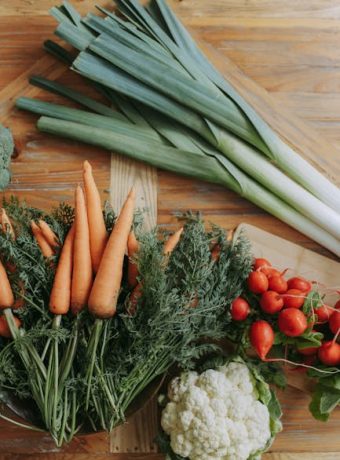Healthy Food in French Cuisine: Light and Delicate Choices
When most people think of French cuisine, they often imagine rich, indulgent dishes laden with butter, cream, and cheese. While it’s true that French food can be decadent, there’s another side to it that is equally delightful – the light and healthy choices. French cuisine offers a variety of dishes that are not only delicious but also nutritious. In this blog post, we’ll explore some of the healthiest choices in French cuisine and provide tips on how to enjoy these dishes without compromising on flavor.
The Philosophy Behind French Cuisine
French cuisine is deeply rooted in the philosophy of using fresh, high-quality ingredients and preparing them with care. This approach naturally lends itself to creating dishes that are both healthy and flavorful. The French have a strong emphasis on seasonal produce, which means their dishes are often packed with vitamins and nutrients.
Moderation is Key
One of the reasons French people are known for their slim figures despite their rich cuisine is their practice of moderation. Portion sizes are typically smaller, and meals are enjoyed slowly, allowing for better digestion and a greater sense of satiety.
Healthy French Dishes to Try
Let’s dive into some specific dishes that exemplify the lighter side of French cuisine.
Ratatouille
Ratatouille is a classic Provençal dish that is both healthy and satisfying. Made with a variety of vegetables such as eggplant, zucchini, bell peppers, and tomatoes, this dish is a nutritional powerhouse. It’s typically seasoned with herbs like thyme and basil, adding a burst of flavor without extra calories. According to the USDA, one serving of ratatouille provides about 80 calories, 3 grams of protein, and a significant amount of vitamins A and C.
Salade Niçoise
Salade Niçoise is another healthy option that’s perfect for a light meal. This salad is traditionally made with fresh vegetables, hard-boiled eggs, tuna, and olives. The combination of protein from the tuna and eggs, along with the fiber from the vegetables, makes it a balanced and nutritious choice. A typical Salade Niçoise contains around 250 calories, 15 grams of protein, and plenty of omega-3 fatty acids, which are excellent for heart health.
Cooking Techniques for Healthier French Cuisine
How you cook your food can significantly impact its nutritional value. Here are some traditional French cooking techniques that prioritize health without sacrificing taste.
Poaching
Poaching is a gentle cooking method that involves simmering food in water or broth. This technique is often used for fish, chicken, and eggs. Poaching preserves the natural flavors of the ingredients while keeping the fat content low. For instance, poached salmon is an excellent source of lean protein and omega-3 fatty acids, making it a heart-healthy choice.
Grilling
Grilling is another popular method in French cuisine, especially during the summer months. Grilling vegetables, fish, and lean meats can add a smoky flavor without the need for excessive oils or fats. Grilled vegetables like bell peppers, zucchini, and asparagus are not only delicious but also packed with antioxidants and vitamins.
French Wines: A Guilt-Free Pleasure
No discussion of French cuisine would be complete without mentioning wine. While alcohol should be consumed in moderation, it’s worth noting that French wines, particularly red wines, contain antioxidants like resveratrol, which can offer health benefits. Studies have shown that moderate wine consumption can improve heart health and reduce the risk of certain diseases.
Choosing the Right Wine
When selecting a wine, opt for those with lower alcohol content and fewer added sugars. Red wines, such as Pinot Noir and Merlot, are generally healthier options due to their higher levels of antioxidants.
Tips for Enjoying Healthy French Cuisine at Home
Here are some actionable tips to help you incorporate healthy French cuisine into your daily life:
Shop Seasonally
Take a cue from the French and shop for seasonal produce. Not only is it more nutritious, but it also tends to be more flavorful and less expensive.
Focus on Quality Ingredients
Invest in high-quality ingredients, especially when it comes to proteins and fats. Choose grass-fed meats, wild-caught fish, and organic vegetables to ensure you’re getting the best nutrition possible.
Practice Portion Control
As mentioned earlier, the French are masters of moderation. Serve smaller portions and take the time to savor each bite. This not only enhances your dining experience but also helps you eat less overall.
Experiment with Herbs and Spices
Instead of relying on heavy sauces and oils, use herbs and spices to add flavor to your dishes. Herbs like thyme, rosemary, and tarragon are staples in French cooking and can elevate the taste of your meals without adding extra calories.
Cook at Home
One of the best ways to ensure you’re eating healthy is to cook at home. This gives you control over the ingredients and cooking methods, allowing you to create nutritious meals that align with your dietary goals.
Conclusion
French cuisine doesn’t have to be synonymous with rich, calorie-laden dishes. By focusing on fresh, high-quality ingredients and employing healthier cooking techniques, you can enjoy delicious French meals that are also good for you. Whether you’re making a hearty ratatouille, a refreshing Salade Niçoise, or simply savoring a glass of red wine, there are plenty of light and delicate choices within French cuisine. Remember, the key is moderation and mindful eating. Bon appétit!


